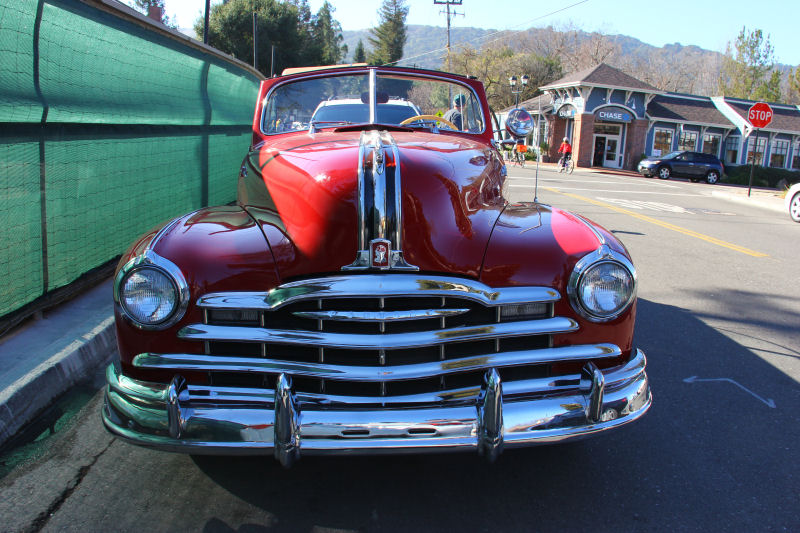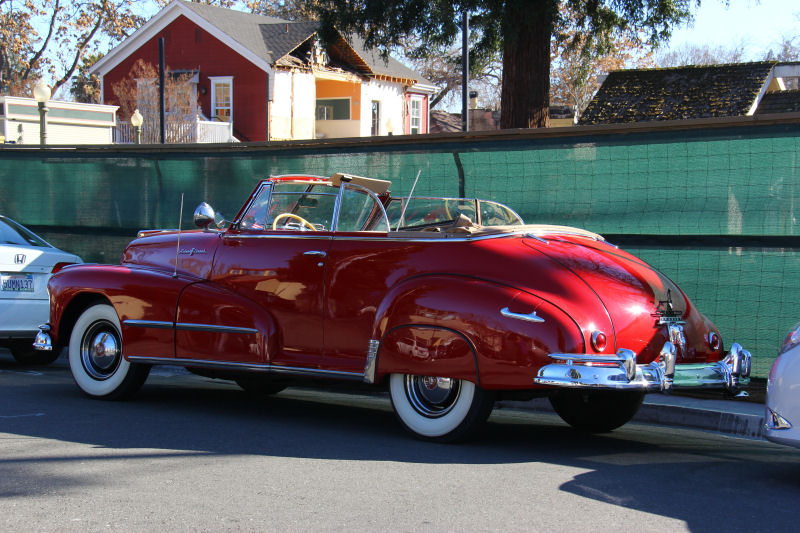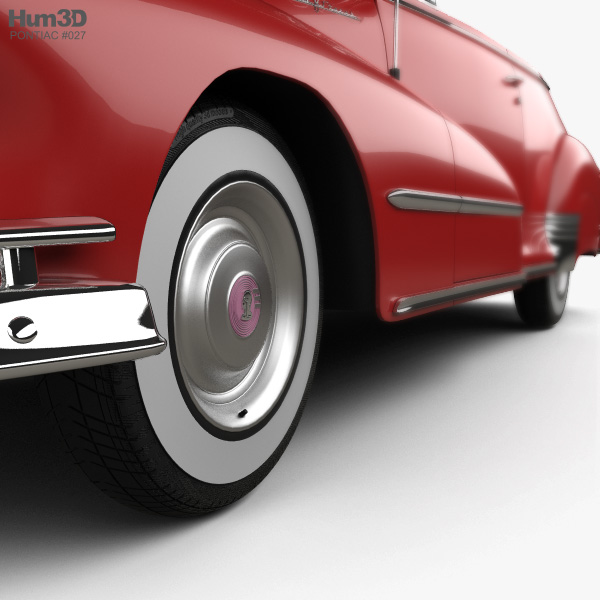If you utter the words “Silver Streak,” younger people may think you are talking about the comparatively recent movie starring Gene Wilder and Richard Pryor. Train buffs might think you are referring to the original record-breaking fast passenger train by that name that went from Denver to Chicago in just 16 hours in 1934.

But car buffs will most likely think you mean the Pontiacs built from 1935 into the 1950s, that had what the company called its Silver Streak styling. These cars, as well the legendary train, were both products of the streamlined design thinking made popular during the Great Depression. While the styling may have lent a little aerodynamic efficiency to both the cars and the trains, it mostly gave them a fast, clean, shimmering new look.

The 1948 Pontiac Torpedo Silver Streak 8 convertible we tested for this driveReport has streamlined styling in abundance. Its bodywork is flowing and sensuous, and its famous stainless steel speed line trim running up over the hood (plus all of the other chrome accents) are an emphatic expression of that look. Our driveReport car’s deep red paintwork offsets these accents beautifully, too, making the car almost irresistible to the eye. In 1948, the words Silver 8 Streak were actually emblazoned on the sides of the hood, with the 8 in the middle.

Driving the Silver Streak is even more of a treat than beholding the car. It takes only a few seconds to get used to the controls. Rectangular side panels that feature the usual easy-to-read gauges flank the large, round speedometer. The deluxe radio in the center of the dash looks like a shimmering waterfall, and the large clock in the glove compartment door nicely counterbalances the instrument cluster. The brake and gas pedal are large and comfortably placed, and there are acres of leg and headroom. The front seat is like a living room sofa, though the back seat is a little tight.

The only thing that gives us a moment’s pause is the arrangement of the gears for the transmission. They are not in the standard PRNDL sequence of today. Instead there is just Neutral, Drive, Low and Reverse, in that order. No Park. If you stop on a hill, the driver’s handbook instructs you to pull the car into low, then shut the engine off and shift into reverse.

General Motors’ Hydra-Matic fully automatic transmission debuted in the Oldsmobile line of 1940 and was made available to Cadillac in 1941, but 1948 was the first year it was offered in the Pontiac line. It was a popular $185 extra-cost option that made Pontiac the least expensive car available with an automatic. About 50 percent of that year’s six-cylinder models and 80 percent of the eight-cylinder models sold were so equipped.

Our driveReport car’s 249-cu.in. flathead straight-eight starts instantly, and soon settles to a buttery smooth, vibration-free idle. The transmission engages crisply when the shift lever is pulled into drive. There is none of the automatic transmission creep common to cars of the period. A little pressure on the throttle moves the car quickly up through the four speeds. The acceleration is quite good below 45 mph, however the car starts to breathe heavily at around 60. But then that was 15-20 mph over the typical speed limit at the time the car was made.

Top down visibility is unlimited, but with the top up and the back window zipped into place the interior seems a bit dark and cave-like, as was typical of convertible coupes of the era. We depend heavily on the side mirrors when changing lanes. Owner Dave Simon doesn’t seem to mind the rear vision problems, though, because he has a collection of over 30 cars, although his ’48 Pontiac is a family favorite. He even has clear plastic seat covers over the original interior so the grandkids can come along for an ice cream without drama.

The Pontiac exhibits a bit of body lean when cornering, but that too was typical of the era. Bumps are absorbed quite nicely by the Pontiac’s soft springs, and braking is adequate for the car’s design envelope. The long, tapered hood makes the car seem bigger than it really is. You can’t see the passenger side front fender from the driver’s seat, so you have to be careful when turning into tight places.
The word “fast” would not spring to your lips when driving a Silver Streak Eight, but the car isn’t a slug, either, when compared to similarly priced automobiles of the time. The Hydra-Matic does not seem to eat up torque the way other early automatics do. We can see why Simon loves the car. It is comfortable, smooth and quiet. There is none of the top mechanism rattle or cowl shake you expect from old convertibles. The engine, transmission and running gear are rock solid and dependable, even if they aren’t terrifyingly exciting.
The car accelerates smoothly, but goes through all of its gears almost before you can clear an intersection. The engine has tons of low-end torque but runs out of revs quickly by modern standards. Bumps and irregularities in the pavement are softened to insignificance by the suspension. People smile and point as we glide by. We see that we are making quite a fashion statement when we glance over and spot our reflection flashing along in store windows.
Pontiac had developed the reputation of being the next step above a Chevrolet by 1948. There were two basic body styles-the Torpedo, that rode on a 119-inch wheelbase and shared many body panels with Chevrolet, and the Streamliner that had a 122-inch wheelbase and used the larger BOP (Buick-Oldsmobile-Pontiac) body from the cowl back. In addition, most models in both lines could be purchased in standard or deluxe trim for $90 to $120 more.
Nineteen forty-eight was an especially good year for Pontiac thanks to the new Hydra-Matic transmission. But then Pontiac had been a sales phenomenon ever since its entry into the market as Oakland’s less expensive alternative in 1926. The new Pontiac outsold its more expensive parent right from the start. Other General Motors divisions also offered companion cars during the 1920s, but Pontiac was the only one of them to survive long term, much less thrive.
Smart styling, rock-solid durability and reasonable prices made Pontiac a major success in the 1920s, ’30s and ’40s but pent up post-war demand made sales especially brisk. However, except for the new transmission, the 1948 cars were essentially unchanged from prewar offerings. The drivelines were conventional open types with two Spicer universal joints.
The inline 239.2-cu.in. straight-six and the 249-cu.in. straight-eight cylinder engines, designed in the 1930s, had full-pressure lubrication and insert bearings. Pistons were made of cast iron for durability and close fitting tolerances, but they did increase reciprocating weight so the motors were not high revvers. Standard compression was 6.50:1 on both the six and eight, but engines in cars equipped with Hydra-Matic transmissions sported 7.50:1 high-compression cylinder heads that increased horsepower from 90 to 93 for the six and from 104 to 106 horsepower at 3,800 rpm for the eight.
Both engines were L head or valve-in-block designs. It was a good approach for the time, because the resulting valve train was short and stout, so it seldom needed adjustment. Overhead valves only became a necessity when compression ratios went up over 8.50:1, and that only took place when high-octane fuel became widely available in the early 1950s.
Our driveReport car has nearly all the accessories available in 1948, including the deluxe push button Air King radio, Weather Chief heater, white wall tires and the deluxe trim package. On closed models there was also a rear window wiper available, and there was a Kool Kushion for people who lived in hot climates and didn’t want their backsides to stick to the upholstery.
Driving a 1948 Pontiac convertible with the top down on a nice day down a two-lane country road is truly a delight. It takes you back to an era when getting there was half the fun, and cars were much more than just appliances. The vehicle’s styling adds a dash of Art Moderne elegance altogether missing today.
Dave Simon’s 1948 Pontiac is at home around town or on the highway (provided you speed to the 55 mph speed limit) and easy to drive. Steering is light, the car is quiet and comfortable, and you know it will get you there. It isn’t a hot rod, but then it isn’t high strung either. Tooling around with the top down on a nice day brings an irresistible smile to your face. We don’t know about you, but the words Silver Streak will always conjure up images of classic Pontiacs to us.





